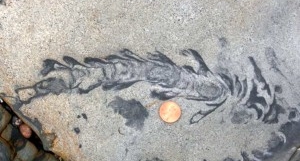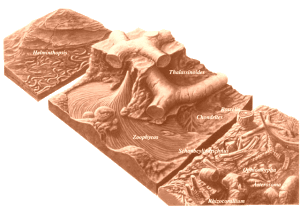Glossary of Trace Fossils Terms
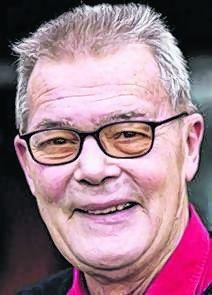 |
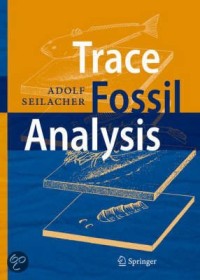
Adolf Seilacher (1925 – 2014) is a German palaeontologist considered by many to be the father of modern ichnology (the study of trace fossils). Among his many contributions to the science, two stand out. First, he was the first to popularize a behavioral classification system for trace fossils that is based on the types of behavior that the traces represent, and he suggested five main behaviorial classes - Cubichnia (resting marks), Domichnia (dwelling). Fodinichnia (deposit feeding/mining), Paschichnia (grazing), and Repichnia (crawling) (Seilacher, 1953 & 1964). Second, he developed the concept of ichnofacies, which uses trace fossil assemblages to interpret ancient sedimentary environments (Seilacher, 1967). He was also skilled at using the camera lucida to make drawings of trace fossils from hand samples that he collected in the field, and he was especially known for the iconic illustrations that he created for his publications. Many of these illustrations appear in his His Trace Fossil Analysis (2007), which is considered one of the definitive works on ichnology. Most of the illustrations on this web page are in fact based on Seilacher's figures. |
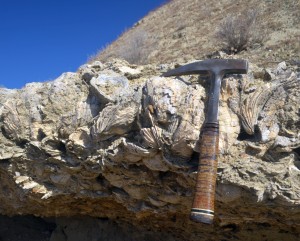
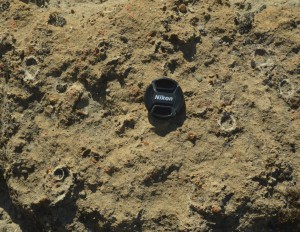 |
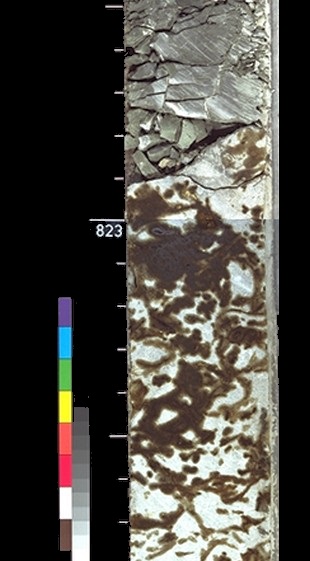
Burrowed Hardgrounds - A marine sedimentary surface that was exposed and partially lithified during very-low to non-existent sedimentation, allowing extensive colonization by burrowing organisms. This can happen in shelf settings during maximum rates of relative sea-level fall (decreasing accommodation), when sediment bypasses the shelf and travels out to deeper parts of the basin. Burrowed hardgrounds forming in these settings are time-significant surfaces that correlate to sequence boundaries. Some burrowed hardgrounds in the San Joaquin Valley are closely associated with dense accumulations of unbroken, in-place, articulated bivalves, which represent colonies that thrived in the shallow-marine and clean, clay-free water conditions facilitated by sediment bypass during falling sea level. The outcrop example on the lower left shows large Ophiomorpha, smaller Skolithos, and other burrows developed on a hardground at the top of a coarsening-upward cycle in the Santa Margarita Formation (Upper Miocene) at Skunk Hollow on the edge of Coalinga Field (west side San Joaquin Valley). This is the same surface that contains the Ophiomorpha "pebble burrows" described elsewhere. Immediately above this surface are densely packed, in-place, unbroken oysters, such as those shown in the photograph above the burrows. The core specimen on the right, which is from the S7-3 well at Coalinga, shows a burrowed hardground at the top of the Temblor Formation (Lower Miocene) that is intensely burrowed by Thalassinoides, and abruptly (unconformably?) overlain by unburrowed shales. |
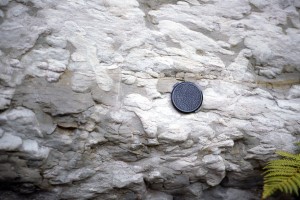 |
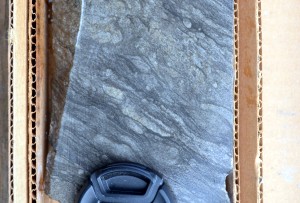 Bioturbation - When organisms burrow through sediment, the process wherein they disrupt bedding and destroy the sedimentary structures is called bioturbation, a term that first appeared in print as "bioturbate textur" in an article written in German by Rudolf Richter (1952) on his observations of modern processes in the North Sea tidal flats. However, Richter and his colleagues had probably used the term informally for many years prior to the publication.
The degree of bioturbation can be moderate, so that some of the original sedimentary fabric is still evident, as with the Thalassinoides burrows in the Cozy Dell Formation outcrop on the left. Or it can be intense, so that all evidence of the original bedding is destroyed, as in the middle part of the core on the right from the Phacoides sandstone (Temblor Formation) in the SP-32X well at South Belridge oil field (San Joaquin Valley).
Bioturbation - When organisms burrow through sediment, the process wherein they disrupt bedding and destroy the sedimentary structures is called bioturbation, a term that first appeared in print as "bioturbate textur" in an article written in German by Rudolf Richter (1952) on his observations of modern processes in the North Sea tidal flats. However, Richter and his colleagues had probably used the term informally for many years prior to the publication.
The degree of bioturbation can be moderate, so that some of the original sedimentary fabric is still evident, as with the Thalassinoides burrows in the Cozy Dell Formation outcrop on the left. Or it can be intense, so that all evidence of the original bedding is destroyed, as in the middle part of the core on the right from the Phacoides sandstone (Temblor Formation) in the SP-32X well at South Belridge oil field (San Joaquin Valley).
|
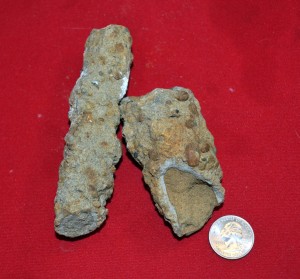
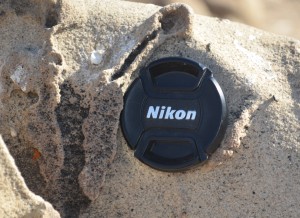
|
Casts & Molds - Trace fossils are generally represented as casts, molds, cross-sections, or impressions, the latter simply being a low-relief, near two-dimensional representation of either a cast or mold. Examples of a couple of Ophiomorpha burrow casts are shown in the upper right photo, an Ophiomorpha mold is shown on the lower left, and below and center is an oblique cross-section view of another Ophiomorpha. Another cross-section view of an Ophiomorpha burrow, but this one in core, is on the right. The locations of these Ophiomorpha burrows are given on the Opiomorpha web page.
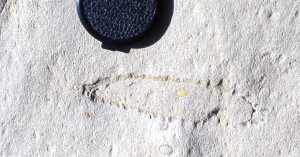 Casts are particularly exciting as they are 3D representations of what burrows, or in some cases organisms, actually looked like. More examples of casts are shown below. Casts of Thalassinoides burrows are shown in the two photos on either end. The center left photo shows casts of Skolithos burrows in the Middle Eocene Cozy Dell Formation at Sespe Creek in the Topatopa Mountains of California, and the center right shows a cast of a Zoophycos burrow excavated by Dr. Peter Pervesler with an air brush out of the Miocene Grund Formation in Austria. The middle photo is especially interesting. It shows the cast of a shark egg case found in the Pennsylvanian Raccoon Mountain Formation in the staircase of the Great Stone Door in Tennessee. It resembles a burrow cast, but it is actually the cast of a soft-bodied shark egg with no hard parts to preserve. |
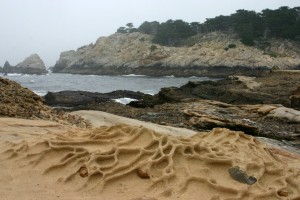
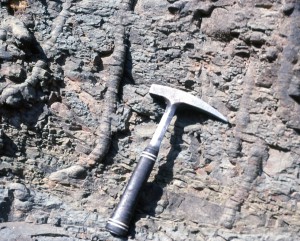
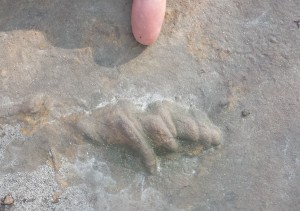
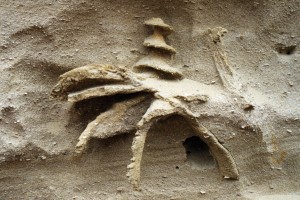
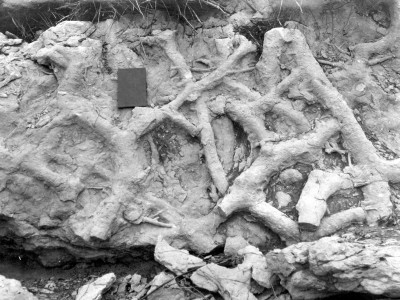
| |
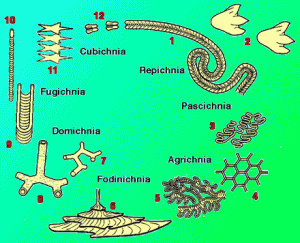 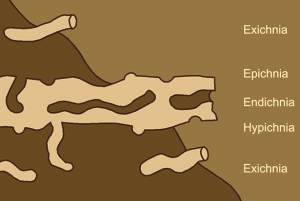 |
Classification of Trace Fossils -
Although many trace fossil classification systems have been proposed over the decades, only three have enjoyed any measure of acceptance by the geologic community. The others for the most part have been forgotten.
The most widely used system is the behavioral (or ethological) classification of Adolph Seilacher, which bears some similarity to an earlier system proposed by Krejci-Graf (1932). Both systems erect behavioral categories (classes) based on the types of animal behavior that a trace might represent. For example, Krejci-Graf (1932) recognizes three behavioral classes - traces of motion, traces of rest, and traces of existence - whereas Seilacher proposes several classes. He originally came up with the first five behaviors in the list below, and two others have been added and accepted over the years. New categories are proposed all the time, but most are quickly pushed aside and forgotten.
Another widely accepted system is one proposed by Martinsson (1965 & 1970) that classifies traces by how and where they are preserved in sediment.
Mikuláš (1999) has also proposed a classification systems for plant trace fossils that has gained fairly wide acceptance. It includes the classes below.
|
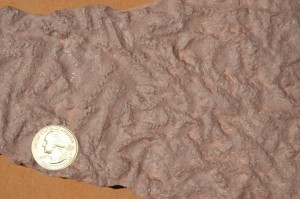
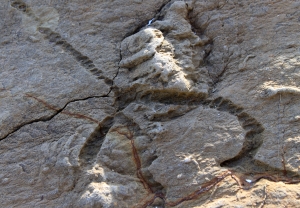
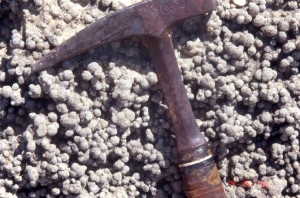

From left to right are examples of Hypichnia (Neonereites), Epichnia (Scalarituba), Endichnia (Macaronichnus) and Exichnia (Thalassinoides) traces. | |
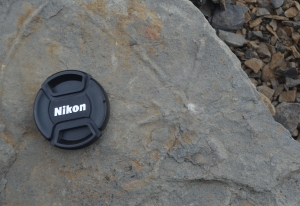 |
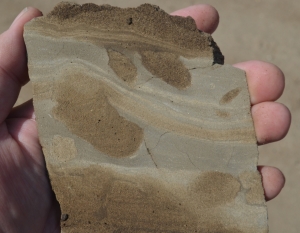 Compaction - When sands and shales change into rocks during burial, they are compacted by the overburden above so that the sand layers end up about half the thickness they were when first deposited, whereas the shales end up about one-fourth their original thickness. For example, the beds in the core at right were originally constant thicknesses, and the bed boundaries paralleled one another. However, where an interval of shale contains sand-filled burrows (either Teichichnus or Asterosoma), it compacted much less than adjacent shale intervals without burrows. As a result, bedding laminations drape over, around, and under the burrows.
A Chondrites burrow in outcrop is shown on the left. This trace when first created was a system of burrow tubes that radiated out from a central point, and inclined downward to form a cone-shaped pattern in three dimensions. However, the burrow tubes are flattened during compaction to near horizontal, such that the 3D burrow geometry becomes distorted to now resemble the flattened spokes of a wagon wheel.
Compaction - When sands and shales change into rocks during burial, they are compacted by the overburden above so that the sand layers end up about half the thickness they were when first deposited, whereas the shales end up about one-fourth their original thickness. For example, the beds in the core at right were originally constant thicknesses, and the bed boundaries paralleled one another. However, where an interval of shale contains sand-filled burrows (either Teichichnus or Asterosoma), it compacted much less than adjacent shale intervals without burrows. As a result, bedding laminations drape over, around, and under the burrows.
A Chondrites burrow in outcrop is shown on the left. This trace when first created was a system of burrow tubes that radiated out from a central point, and inclined downward to form a cone-shaped pattern in three dimensions. However, the burrow tubes are flattened during compaction to near horizontal, such that the 3D burrow geometry becomes distorted to now resemble the flattened spokes of a wagon wheel.
|
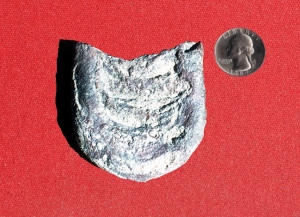 |
Escape Burrows - Vertical burrows with concave-up spreite are sometimes referred to as "escape burrows", as they represent attempts by the organism during periods of high sedimentation to prevent the burrow entrance from being buried, and at the same time keep the bottom of the burrow at the same depth from the sediment-water interface. In essence, the organism "escapes" from being buried too deeply by progressively tunneling upward, thereby leaving behind it a stacked vertical succession of concave-up spreite. Although not generally found in the San Joaquin Valley, Diplocraterion (see example at left) is the classic example of a vertical escape burrow with spreite. Rosselia, and the very similar Conichnus, both of which are found in the valley, are also vertical escape burrows. |
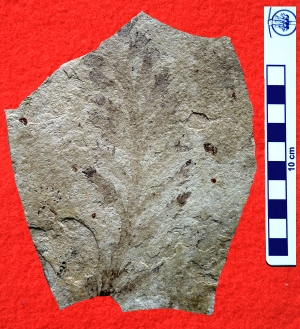 |
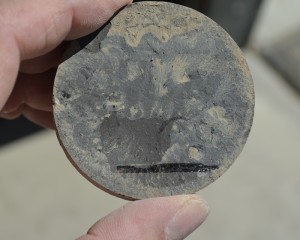 Fucoids - Brown algae, which is simply another name for common seaweed or kelp, are plants belonging to the order Fucales, which are also referred to as fucoids. Many trace fossils - for example Zoophycos, Hillichnus, Thalassinoides, Ophiomorpha, Chondrites, Cruziana and Rusophycos - were first classifed in the 19th century as fossil fucoids, and only later recognized to be invertebrate burrows. In fact, fossil burrows with the suffix of -phycos in most instances were originally interpreted as fucoids.
Fucoids - Brown algae, which is simply another name for common seaweed or kelp, are plants belonging to the order Fucales, which are also referred to as fucoids. Many trace fossils - for example Zoophycos, Hillichnus, Thalassinoides, Ophiomorpha, Chondrites, Cruziana and Rusophycos - were first classifed in the 19th century as fossil fucoids, and only later recognized to be invertebrate burrows. In fact, fossil burrows with the suffix of -phycos in most instances were originally interpreted as fucoids.
Although true fossil fucoids are in fact quite rare, examples do exist. An impression of an elaborate, branching fossil fucoid (genus Paleocystophora) from the Miocene Monterey Formation is shown on the left. It is from the paleobotanical type collection of University of California Museum of Paleonotology at Berkeley. Simple, single-strand fossil fucoids are also found in the San Joaquin Valley in the Miocene Santos Shale, as in the core specimen on the right. Below is an example of a Hillichnus trace that was once mistakenly thought in the 1930s to be a fossil fucoid when it was first described. However, it is now considered to be the feeding burrow of a marine snail. This specimen is from the Paleocene Carmelo Formation at Point Lobos in California. |
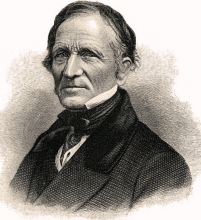 |
History of Ichnology - Ichnology is the study of trace fossils, and it dates as a science back to the 1830s when early geologists found dinosaur tracks and attributed them to giant extinct birds. However, it was not until the 1880s that geologists realized that nature could also preserve the burrows and grazing trails of soft-bodied animals such as worms and shrimp. The next few decades focused on modern studies of burrows and grazing trails, and on the description and identification of ancient ones until Adolph Seilacher in the mid-twentieth century ushered in a new era in ichnology by pioneering the use of trace fossil assemblages (which are better known as Ichnofacies) to interpret environments of deposition. The portrait on the left is of Edward Hitchcock who was the first to use -ichnus and -ichnites in the suffix of trace fossil names. Hitchcock also coined the term "ichnolithology" in 1841 for the study of fossil tracks. The Scottish naturalist William Jardine shortened Hitchcock's term in 1851 to "Ichnology", and Hitchcock subsequently adopted Jardine's abreviated term when he published his 1858 study on the Ichnology of New England. More on the History of Ichnology |
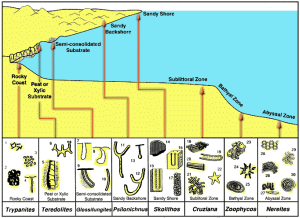
|
Ichnofacies - An assemblage of trace fossils that characterizes an environment in terms of water depths, current energy, and marine versus non-marine conditions. Although the organisms that make a specific trace fossil can, and often do, change over time, the assemblage of trace fossils in each of the ichnofacies listed below do not change. In fact, these assemblages have stayed the same since they first appeared hundreds of millions of years ago during the Cambrian (and in some cases even earlier). Thus, ichnofacies are reliable records of ancient environments. The concept of ichnofacies is one of the many contributions to ichnology made by Adolf Seilacher.
|
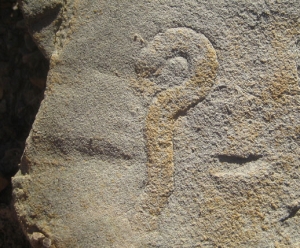 |
Ichnogenera and Ichnospecies - The genus and species names of trace fossils are called ichnogenera and ichnospecies, and paleontologists since the early 1800s have been assigning these names to traces in the same way they are given to plants and animals. In additon, attempts are made from time to time to further organize ichnogenera into a Linnaean-type system of classes, orders and families, but these efforts largely fail for the simple reason that trace fossil names refer only to the form of the burrow, and not to the animal that made it. This is because more than one animal may have made a given trace. Also, many invertebrates have no hard parts to leave behind as fossils, which means that it can be very difficult, if not impossible, to determine what organism made the trace. After all, if a soft-bodied animal is never preserved with the burrow or trail that it left behind, we can never know with certainty the identity of that animal. For this reason ichnology has adopted a behavioral classification system, first proposed by Adolf Seilacher (1953 & 1964), that is based on the purpose for which the trace was created. |
| Ichnology - See History of Ichnology | |
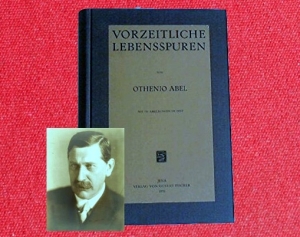 |
Lebensspuren (Trace Fossils) - A german term synonymous with trace fossils that translates to the "tracks, traces or remains of ancient life", and refers to the burrows, trackways and body impressions of ancient animals, as opposed to body fossils such as bones or shells. Although animal traces are generally implied, some extend the definition to include plant impressions as well. The origin of the word probably dates to 1849 when French naturalist Alcide d'Orbigny (1802-1857) used "trace physiologique" to distinguish trace fossils from body fossils in an early paleontological treatise. German paleontologists subsequently translated this as "lebensspuren", but the german term did not actually appear in print until 1912 when Professor Othenio Abel (1875-1946) used it in an article. Although Abel in 1935 published an exhaustive catalog of trace fossils under the title Vorzeitliche Lebensspuren ("Prehistoric Traces of Life"), the term after WWII more or less fell into disuse. It was resurrected many years later when Japanese paleontologists revived it as they began reaching out to a broader audience by publishing their trace fossil articles in English. |
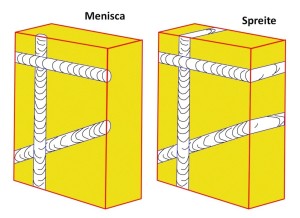 |
Spreite and Menisci - Some burrows display tabular, curved laminations that form when an organism tunnels back and forth through the sediment in search of food. These concave-up laminations are called spreite. Basically, the organism moves just enough on each pass through to avoid reworking a previously tunneled area. Spreiten may also form as an organism moves a U-shaped or V-shaped burrow upward in response to sedimentation. Traces with these types of spreite are also known as Escape Burrows. In addition, spreiten will form in horizontal U-shaped burrows, such as Rhizocorallium, as the organism moves the terminus of the burrow forward. Protrusive spreite result from movement of an organism away from its burrow entrance (i.e., a downward movement in vertical burrows), whereas retrusive spreite result from movement towards the burrow entrance (i.e., an upward movement in vertical burrows)
Spreite differ from menisci, which are flat to slightly curved, back-filling structures that are formed when the organism packs sediment and fecal matter behind itself as it moves through the burrow. Menisci generally appear as flat to curved partitions within the burrow that are derived from sediment layers that were in front of the organism just before it tunneled through them. Teichichnus and Rhizocorallium are examples of spreiten burrows, whereas Adhesive Meniscate Burrows (AMBs) and Muensteria are examples of meniscate burrows. |
| Trace Fossils - See Lebenspurren | |
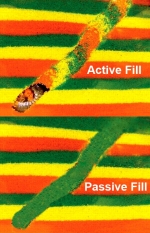 |
Types of Burrow Fill - There are two main categories of burrow fill
|


